A High-Resolution Distribution Dataset of Paddy Rice in India Based on Satellite Data
Abstract
1. Introduction
2. Materials and Methods
2.1. Study Area
2.2. Data
2.3. Identification Method of Paddy Rice in India
- 1.
- Distinguish vegetated and temporary water body areas
- 2.
- Calculation of V and W line values
- 3.
- Calculation of the SPRI value
- 4.
- Generation of a rice recognition map
2.4. Statistical Analysis
2.5. Conceptual Flowchart
3. Results
3.1. Identification Accuracy of Winter Rice
3.2. Identification Accuracy of Summer Rice
3.3. Identification Accuracy of Autumn Rice
3.4. Spatial Patterns of Rice
4. Discussion
5. Conclusions
Author Contributions
Funding
Data Availability Statement
Acknowledgments
Conflicts of Interest
Appendix A

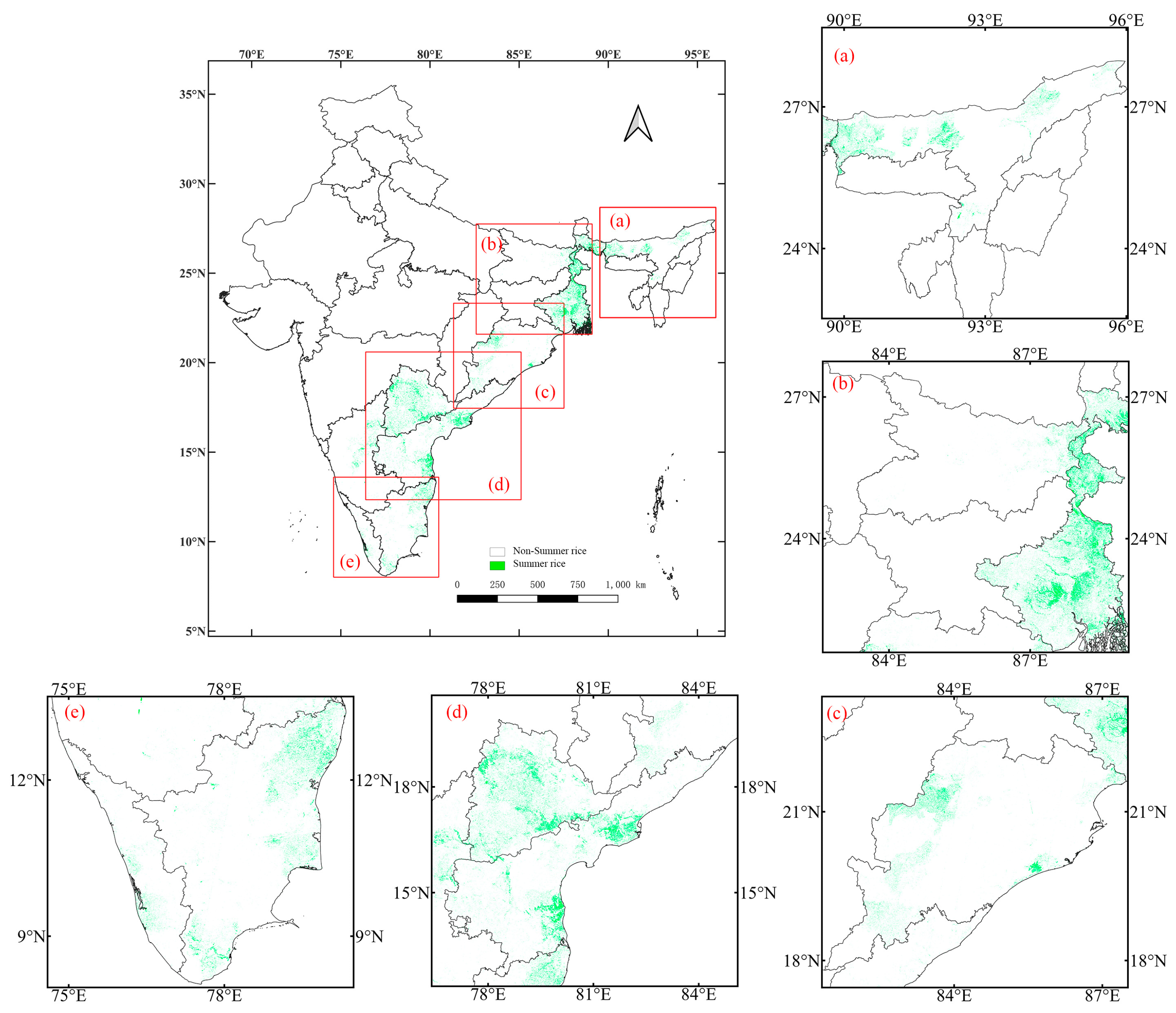
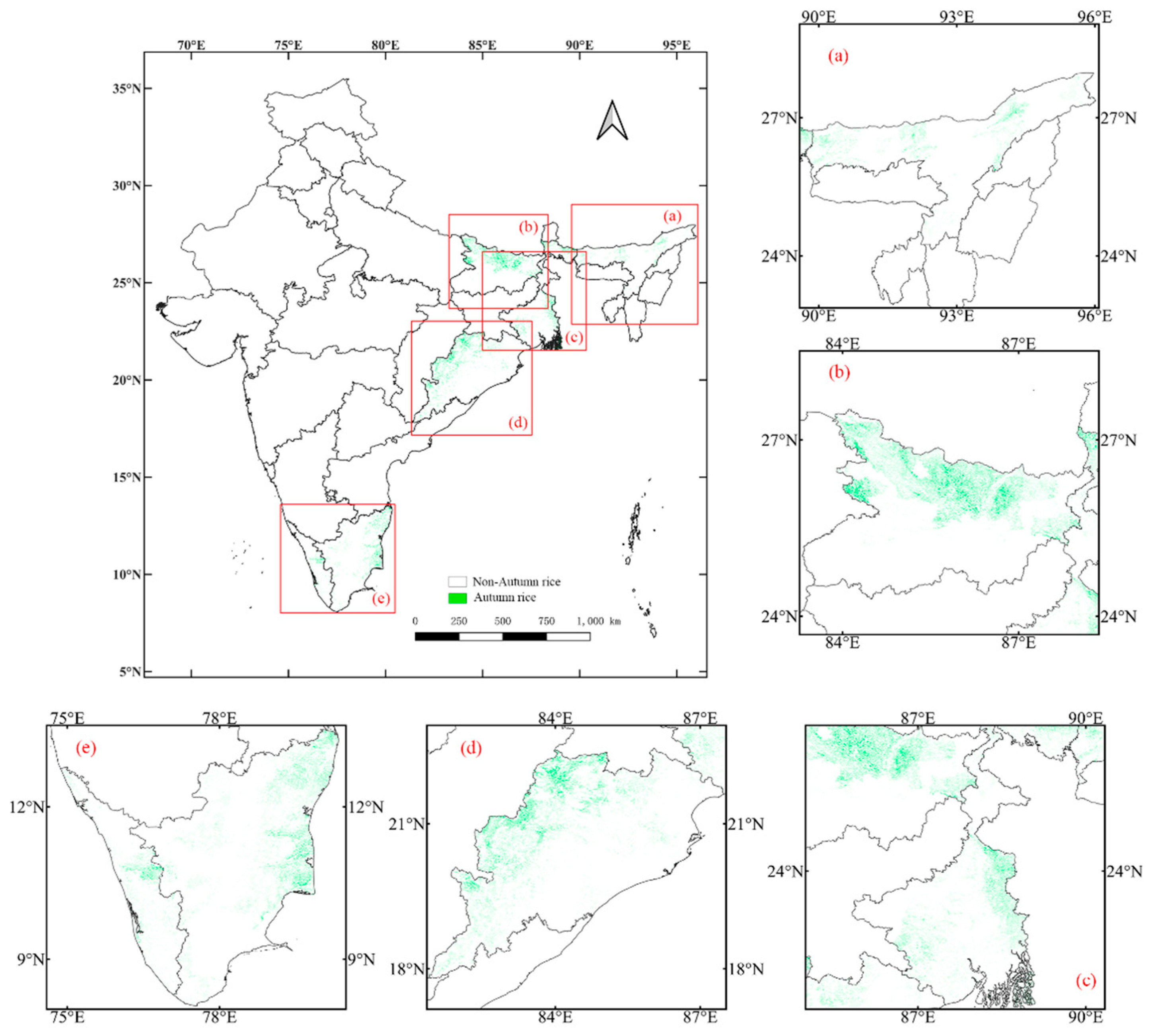
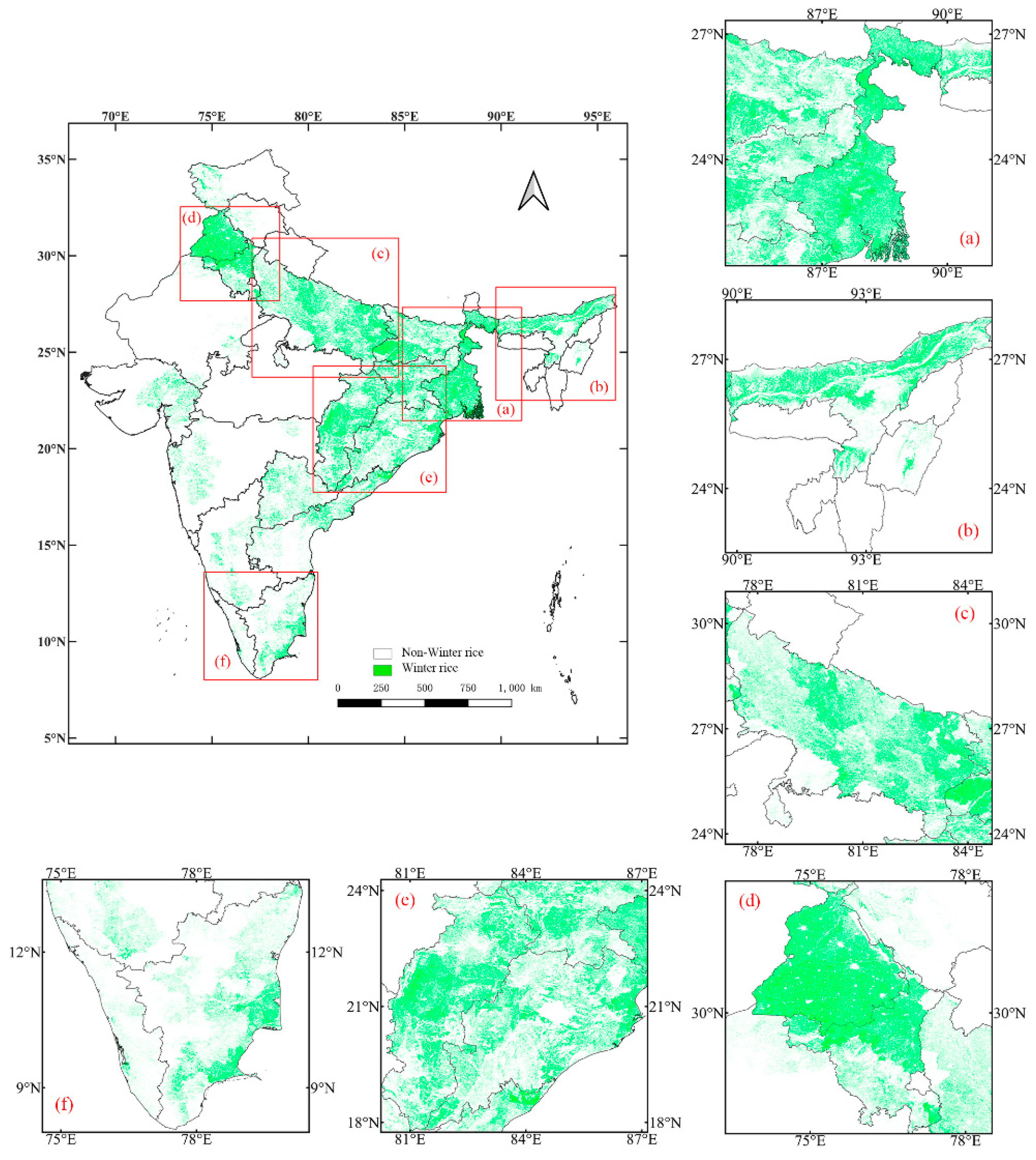
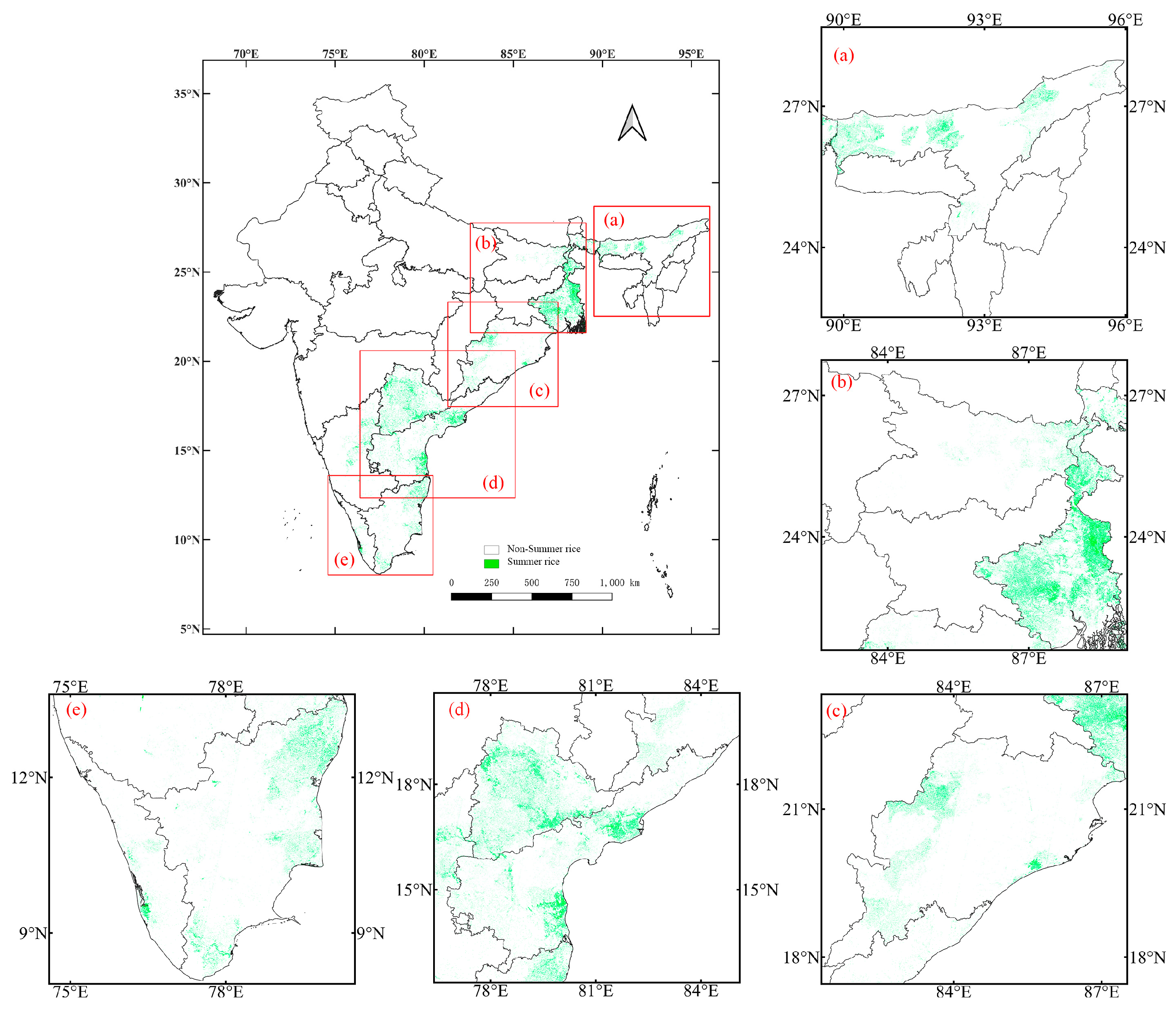

References
- FAO. World Food and Agriculture—Statistical Yearbook 2019; FAO: Rome, Italy, 2019; ISBN 978-92-5-131242-2. [Google Scholar]
- Rudiyanto; Minasny, B.; Shah, R.M.; Che Soh, N.; Arif, C.; Indra Setiawan, B. Automated Near-Real-Time Mapping and Monitoring of Rice Extent, Cropping Patterns, and Growth Stages in Southeast Asia Using Sentinel-1 Time Series on a Google Earth Engine Platform. Remote Sens. 2019, 11, 1666. [Google Scholar] [CrossRef]
- Xu, S.; Zhu, X.; Chen, J.; Zhu, X.; Duan, M.; Qiu, B.; Wan, L.; Tan, X.; Xu, Y.N.; Cao, R. A Robust Index to Extract Paddy Fields in Cloudy Regions from SAR Time Series. Remote Sens. Environ. 2023, 285, 113374. [Google Scholar] [CrossRef]
- Bandumula, N. Rice Production in Asia: Key to Global Food Security. Proc. Natl. Acad. Sci. India Sect. B Biol. Sci. 2018, 88, 1323–1328. [Google Scholar] [CrossRef]
- Bouman, B.A.M.; Humphreys, E.; Tuong, T.P.; Barker, R. Rice and Water. In Advances in Agronomy; Sparks, D.L., Ed.; Academic Press: Cambridge, MA, USA, 2007; Volume 92, pp. 187–237. [Google Scholar]
- Singha, M.; Dong, J.; Zhang, G.; Xiao, X. High Resolution Paddy Rice Maps in Cloud-Prone Bangladesh and Northeast India Using Sentinel-1 Data. Sci. Data 2019, 6, 26. [Google Scholar] [CrossRef]
- Chen, H.; Zhu, G.; Zhang, K.; Bi, J.; Jia, X.; Ding, B.; Zhang, Y.; Shang, S.; Zhao, N.; Qin, W. Evaluation of Evapotranspiration Models Using Different LAI and Meteorological Forcing Data from 1982 to 2017. Remote Sens. 2020, 12, 2473. [Google Scholar] [CrossRef]
- Yadav, R.; Subbarao, A. Atlas of Cropping Systems in India. In Atlas of Cropping Systems in India; Project Directorate for Cropping Systems Research: Meerut, India, 2001. [Google Scholar]
- Xiao, X.; Boles, S.; Frolking, S.; Li, C.; Babu, J.Y.; Salas, W.; Moore, B. Mapping Paddy Rice Agriculture in South and Southeast Asia Using Multi-Temporal MODIS Images. Remote Sens. Environ. 2006, 100, 95–113. [Google Scholar] [CrossRef]
- Gumma, M.; Nelson, A.; Thenkabail, P.; Singh, A. Mapping Rice Areas of South Asia Using MODIS Multitemporal Data. J. Appl. Remote Sens. 2011, 5, 053547. [Google Scholar] [CrossRef]
- Bridhikitti, A.; Overcamp, T.J. Estimation of Southeast Asian Rice Paddy Areas with Different Ecosystems from Moderate-Resolution Satellite Imagery. Agric. Ecosyst. Environ. 2012, 146, 113–120. [Google Scholar] [CrossRef]
- Gumma, M.K.; Thenkabail, P.S.; Panjala, P.; Teluguntla, P.; Yamano, T.; Mohammed, I. Multiple Agricultural Cropland Products of South Asia Developed Using Landsat-8 30 m and MODIS 250 m Data Using Machine Learning on the Google Earth Engine (GEE) Cloud and Spectral Matching Techniques (SMTs) in Support of Food and Water Security. GISci. Remote Sens. 2022, 59, 1048–1077. [Google Scholar] [CrossRef]
- Wang, J.; Huang, J.; Zhang, K.; Li, X.; She, B.; Wei, C.; Gao, J.; Song, X. Rice Fields Mapping in Fragmented Area Using Multi-Temporal HJ-1A/B CCD Images. Remote Sens. 2015, 7, 3467–3488. [Google Scholar] [CrossRef]
- Clauss, K.; Yan, H.; Kuenzer, C. Mapping Paddy Rice in China in 2002, 2005, 2010 and 2014 with MODIS Time Series. Remote Sens. 2016, 8, 434. [Google Scholar] [CrossRef]
- Dong, J.; Xiao, X.; Menarguez, M.A.; Zhang, G.; Qin, Y.; Thau, D.; Biradar, C.; Moore, B. Mapping Paddy Rice Planting Area in Northeastern Asia with Landsat 8 Images, Phenology-Based Algorithm and Google Earth Engine. Remote Sens. Environ. 2016, 185, 142–154. [Google Scholar] [CrossRef] [PubMed]
- Cao, D.; Feng, J.; Bai, L.; Xun, L.; Jing, H.; Sun, J.; Zhang, J. Delineating the Rice Crop Activities in Northeast China through Regional Parametric Synthesis Using Satellite Remote Sensing Time-Series Data from 2000 to 2015. J. Integr. Agric. 2021, 20, 424–437. [Google Scholar] [CrossRef]
- Dong, J.; Xiao, X. Evolution of Regional to Global Paddy Rice Mapping Methods: A Review. ISPRS J. Photogramm. Remote Sens. 2016, 119, 214–227. [Google Scholar] [CrossRef]
- Motohka, T.; Nasahara, K.N.; Miyata, A.; Mano, M.; Tsuchida, S. Evaluation of Optical Satellite Remote Sensing for Rice Paddy Phenology in Monsoon Asia Using a Continuous in Situ Dataset. Int. J. Remote Sens. 2009, 30, 4343–4357. [Google Scholar] [CrossRef]
- Kuenzer, C.; Knauer, K. Remote Sensing of Rice Crop Areas. Int. J. Remote Sens. 2013, 34, 2101–2139. [Google Scholar] [CrossRef]
- Chen, J.; Han, Y.; Zhang, J. Mapping Rice Crop Fields Using C Band Polarimetric SAR Data. In Proceedings of the 2014 the Third International Conference on Agro-Geoinformatics, Beijing, China, 11–14 August 2014; pp. 1–4. [Google Scholar]
- Clauss, K.; Ottinger, M.; Kuenzer, C. Mapping Rice Areas with Sentinel-1 Time Series and Superpixel Segmentation. Int. J. Remote Sens. 2018, 39, 1399–1420. [Google Scholar] [CrossRef]
- Pan, B.; Zheng, Y.; Shen, R.; Ye, T.; Zhao, W.; Dong, J.; Ma, H.; Yuan, W. High Resolution Distribution Dataset of Double-Season Paddy Rice in China. Remote Sens. 2021, 13, 4609. [Google Scholar] [CrossRef]
- Canisius, F.; Shang, J.; Liu, J.; Huang, X.; Ma, B.; Jiao, X.; Geng, X.; Kovacs, J.M.; Walters, D. Tracking Crop Phenological Development Using Multi-Temporal Polarimetric Radarsat-2 Data. Remote Sens. Environ. 2018, 210, 508–518. [Google Scholar] [CrossRef]
- Li, H.; Fu, D.; Huang, C.; Su, F.; Liu, Q.; Liu, G.; Wu, S. An Approach to High-Resolution Rice Paddy Mapping Using Time-Series Sentinel-1 SAR Data in the Mun River Basin, Thailand. Remote Sens. 2020, 12, 3959. [Google Scholar] [CrossRef]
- Ramadhani, F.; Pullanagari, R.; Kereszturi, G.; Procter, J. Automatic Mapping of Rice Growth Stages Using the Integration of SENTINEL-2, MOD13Q1, and SENTINEL-1. Remote Sens. 2020, 12, 3613. [Google Scholar] [CrossRef]
- Küçük, Ç.; Taşkın, G.; Erten, E. Paddy-Rice Phenology Classification Based on Machine-Learning Methods Using Multitemporal Co-Polar X-Band SAR Images. IEEE J. Sel. Top. Appl. Earth Obs. Remote Sens. 2016, 9, 2509–2519. [Google Scholar] [CrossRef]
- Bazzi, H.; Baghdadi, N.; El Hajj, M.; Zribi, M.; Minh, D.H.T.; Ndikumana, E.; Courault, D.; Belhouchette, H. Mapping Paddy Rice Using Sentinel-1 SAR Time Series in Camargue, France. Remote Sens. 2019, 11, 887. [Google Scholar] [CrossRef]
- Fu, Y.; Shen, R.; Song, C.; Dong, J.; Han, W.; Ye, T.; Yuan, W. Exploring the Effects of Training Samples on the Accuracy of Crop Mapping with Machine Learning Algorithm. Sci. Remote Sens. 2023, 7, 100081. [Google Scholar] [CrossRef]
- Zhao, S.; Liu, X.; Ding, C.; Liu, S.; Wu, C.; Wu, L. Mapping Rice Paddies in Complex Landscapes with Convolutional Neural Networks and Phenological Metrics. GISci. Remote Sens. 2020, 57, 37–48. [Google Scholar] [CrossRef]
- Skakun, S.; Franch, B.; Vermote, E.; Roger, J.-C.; Becker-Reshef, I.; Justice, C.; Kussul, N. Early Season Large-Area Winter Crop Mapping Using MODIS NDVI Data, Growing Degree Days Information and a Gaussian Mixture Model. Remote Sens. Environ. 2017, 195, 244–258. [Google Scholar] [CrossRef]
- Dong, J.; Fu, Y.; Wang, J.; Tian, H.; Fu, S.; Niu, Z.; Han, W.; Zheng, Y.; Huang, J.; Yuan, W. Early-Season Mapping of Winter Wheat in China Based on Landsat and Sentinel Images. Earth Syst. Sci. Data 2020, 12, 3081–3095. [Google Scholar] [CrossRef]
- Boryan, C.; Yang, Z.; Mueller, R.; Craig, M. Monitoring US Agriculture: The US Department of Agriculture, National Agricultural Statistics Service, Cropland Data Layer Program. Geocarto Int. 2011, 26, 341–358. [Google Scholar] [CrossRef]
- Xu, J.; Zhu, Y.; Zhong, R.; Lin, Z.; Xu, J.; Jiang, H.; Huang, J.; Li, H.; Lin, T. DeepCropMapping: A Multi-Temporal Deep Learning Approach with Improved Spatial Generalizability for Dynamic Corn and Soybean Mapping. Remote Sens. Environ. 2020, 247, 111946. [Google Scholar] [CrossRef]
- Liu, W.; Dong, J.; Xiang, K.; Wang, S.; Han, W.; Yuan, W. A Sub-Pixel Method for Estimating Planting Fraction of Paddy Rice in Northeast China. Remote Sens. Environ. 2018, 205, 305–314. [Google Scholar] [CrossRef]
- Frolking, S.; Yeluripati, J.B.; Douglas, E. New District-Level Maps of Rice Cropping in India: A Foundation for Scientific Input into Policy Assessment. Field Crops Res. 2006, 98, 164–177. [Google Scholar] [CrossRef]
- Zhang, G.; Xiao, X.; Biradar, C.M.; Dong, J.; Qin, Y.; Menarguez, M.A.; Zhou, Y.; Zhang, Y.; Jin, C.; Wang, J.; et al. Spatiotemporal Patterns of Paddy Rice Croplands in China and India from 2000 to 2015. Sci. Total Environ. 2017, 579, 82–92. [Google Scholar] [CrossRef] [PubMed]
- Waleed, M.; Mubeen, M.; Ahmad, A.; Habib-ur-Rahman, M.; Amin, A.; Farid, H.U.; Hussain, S.; Ali, M.; Qaisrani, S.A.; Nasim, W.; et al. Evaluating the Efficiency of Coarser to Finer Resolution Multispectral Satellites in Mapping Paddy Rice Fields Using GEE Implementation. Sci. Rep. 2022, 12, 13210. [Google Scholar] [CrossRef] [PubMed]
- High-Resolution Distribution Maps of Rice in India for 2018, 2020, and 2022. Available online: https://figshare.com/articles/figure/High-resolution_distribution_maps_of_rice_in_India_for_2018_2020_and_2022/24228619 (accessed on 3 October 2023). [CrossRef]
- Peng, W.; Kuang, T.; Tao, S. Quantifying Influences of Natural Factors on Vegetation NDVI Changes Based on Geographical Detector in Sichuan, Western China. J. Clean. Prod. 2019, 233, 353–367. [Google Scholar] [CrossRef]
- McFEETERS, S.K. The Use of the Normalized Difference Water Index (NDWI) in the Delineation of Open Water Features. Int. J. Remote Sens. 1996, 17, 1425–1432. [Google Scholar] [CrossRef]
- Zhang, X.; Shen, R.; Zhu, X.; Pan, B.; Fu, Y.; Zheng, Y.; Chen, X.; Peng, Q.; Yuan, W. Sample-Free Automated Mapping of Double-Season Rice in China Using Sentinel-1 SAR Imagery. Front. Environ. Sci. 2023, 11, 1207882. [Google Scholar] [CrossRef]
- Dong, J.; Lu, H.; Wang, Y.; Ye, T.; Yuan, W. Estimating Winter Wheat Yield Based on a Light Use Efficiency Model and Wheat Variety Data. ISPRS J. Photogramm. Remote Sens. 2020, 160, 18–32. [Google Scholar] [CrossRef]
- Shen, R.; Dong, J.; Yuan, W.; Han, W.; Ye, T.; Zhao, W. A 30 m Resolution Distribution Map of Maize for China Based on Landsat and Sentinel Images. J. Remote Sens. 2022, 2022, 9846712. [Google Scholar] [CrossRef]
- Shen, R.; Pan, B.; Peng, Q.; Dong, J.; Chen, X.; Zhang, X.; Ye, T.; Huang, J.; Yuan, W. High-Resolution Distribution Maps of Single-Season Rice in China from 2017 to 2022. Earth Syst. Sci. Data Discuss. 2023, 15, 3203–3222. [Google Scholar] [CrossRef]
- Peng, Q.; Shen, R.; Li, X.; Ye, T.; Dong, J.; Fu, Y.; Yuan, W. A Twenty-Year Dataset of High-Resolution Maize Distribution in China. Sci. Data 2023, 10, 658. [Google Scholar] [CrossRef]
- Huang, X.; Fu, Y.; Wang, J.; Dong, J.; Zheng, Y.; Pan, B.; Skakun, S.; Yuan, W. High-Resolution Mapping of Winter Cereals in Europe by Time Series Landsat and Sentinel Images for 2016–2020. Remote Sens. 2022, 14, 2120. [Google Scholar] [CrossRef]
- Dong, J.; Pang, Z.; Lin, S.; Zhang, X.; Xie, Z.; Ren, P.; Zhang, X.; Yuan, W. Cotton Lands Induced Cooling Effect on Land Surface Temperature in Xinjiang, China. Agric. For. Meteorol. 2024, 351, 110004. [Google Scholar] [CrossRef]
- Yadav, S.; Kumar, V.; Singh, S.; Kumar, R.M.; Sharma, S.; Tripathi, R.; Nayak, A.K.; Ladha, J.K. Chapter 8—Growing Rice in Eastern India: New Paradigms of Risk Reduction and Improving Productivity. In The Future Rice Strategy for India; Mohanty, S., Chengappa, P.G., Mruthyunjaya, Ladha, J.K., Baruah, S., Kannan, E., Manjunatha, A.V., Eds.; Academic Press: Cambridge, MA, USA, 2017; pp. 221–258. ISBN 978-0-12-805374-4. [Google Scholar]
- Salas, E.A.L.; Subburayalu, S.K.; Slater, B.; Zhao, K.; Bhattacharya, B.; Tripathy, R.; Das, A.; Nigam, R.; Dave, R.; Parekh, P. Mapping Crop Types in Fragmented Arable Landscapes Using AVIRIS-NG Imagery and Limited Field Data. Int. J. Image Data Fusion 2020, 11, 33–56. [Google Scholar] [CrossRef]
- FAO. World Food and Agriculture—Statistical Yearbook 2020; FAO: Rome, Italy, 2020; ISBN 978-92-5-132345-9. [Google Scholar]
- Steele-Dunne, S.C.; McNairn, H.; Monsivais-Huertero, A.; Judge, J.; Liu, P.-W.; Papathanassiou, K. Radar Remote Sensing of Agricultural Canopies: A Review. IEEE J. Sel. Top. Appl. Earth Obs. Remote Sens. 2017, 10, 2249–2273. [Google Scholar] [CrossRef]
- Le Toan, T.; Ribbes, F.; Wang, L.-F.; Floury, N.; Ding, K.-H.; Kong, J.A.; Fujita, M.; Kurosu, T. Rice Crop Mapping and Monitoring Using ERS-1 Data Based on Experiment and Modeling Results. IEEE Trans. Geosci. Remote Sens. 1997, 35, 41–56. [Google Scholar] [CrossRef]
- Yang, M.; Guo, B.; Wang, J. A Novel and Robust Method for Large-Scale Single-Season Rice Mapping Based on Phenology and Statistical Data. ISPRS J. Photogramm. Remote Sens. 2024, 213, 14–32. [Google Scholar] [CrossRef]
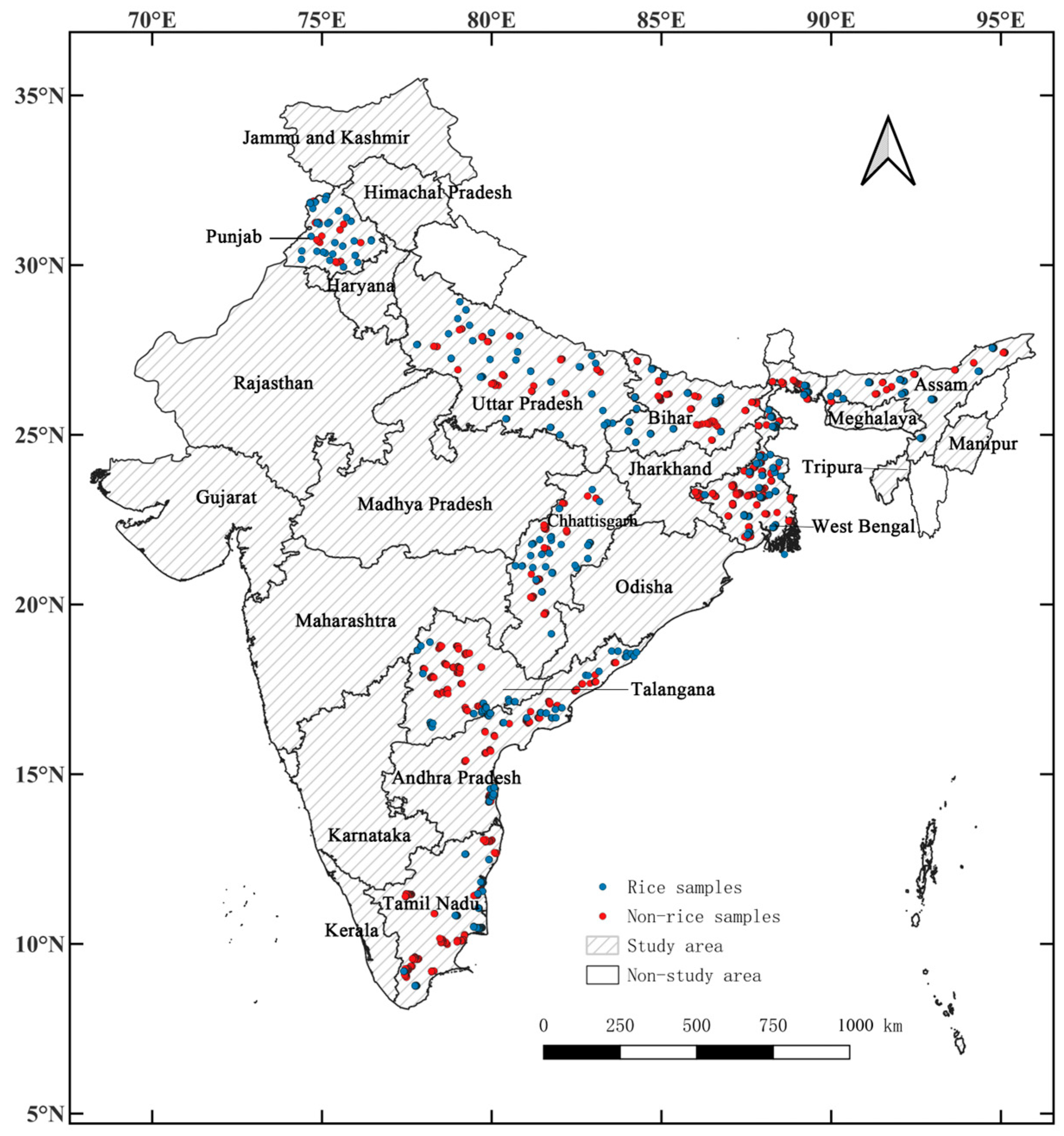


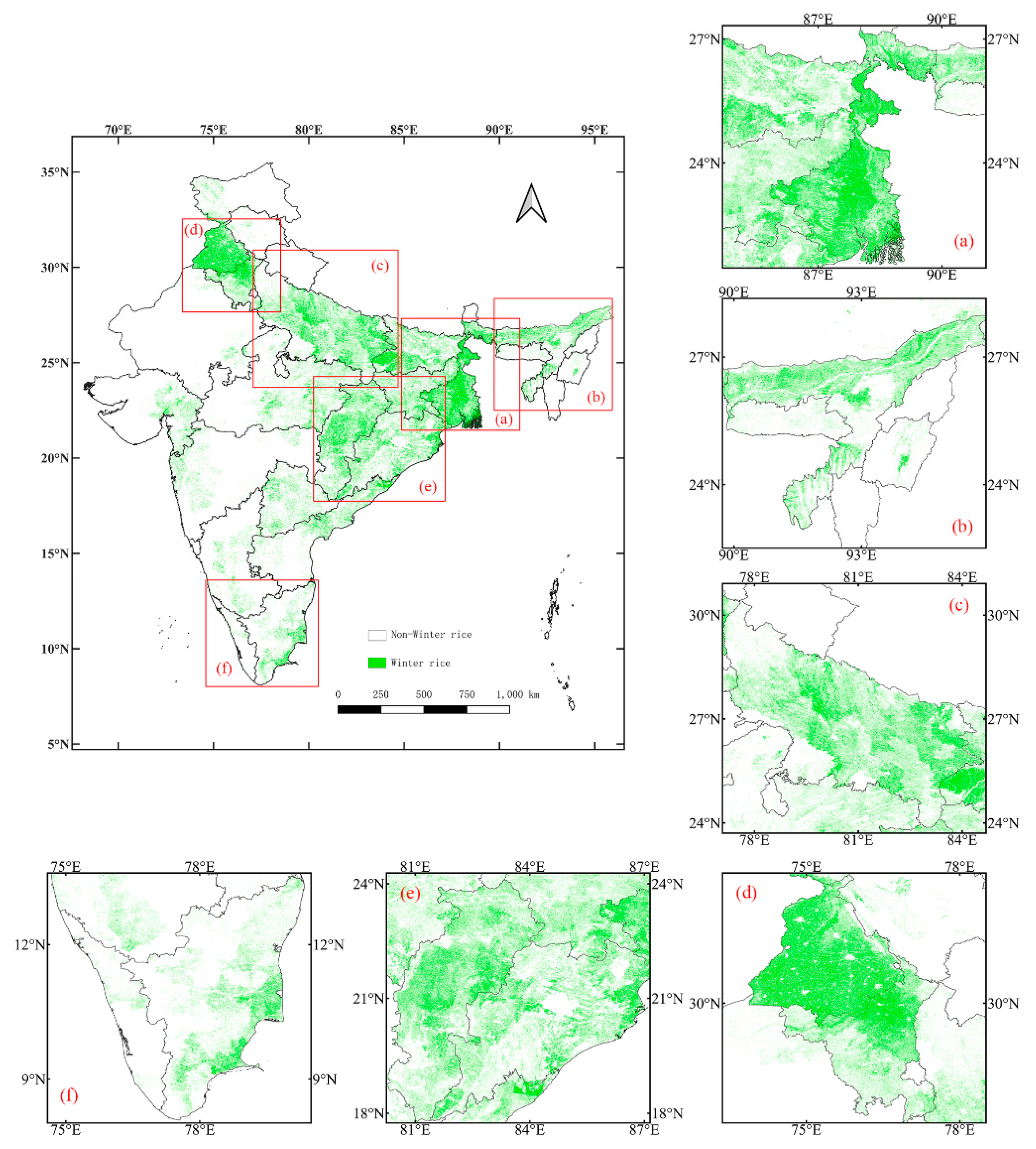
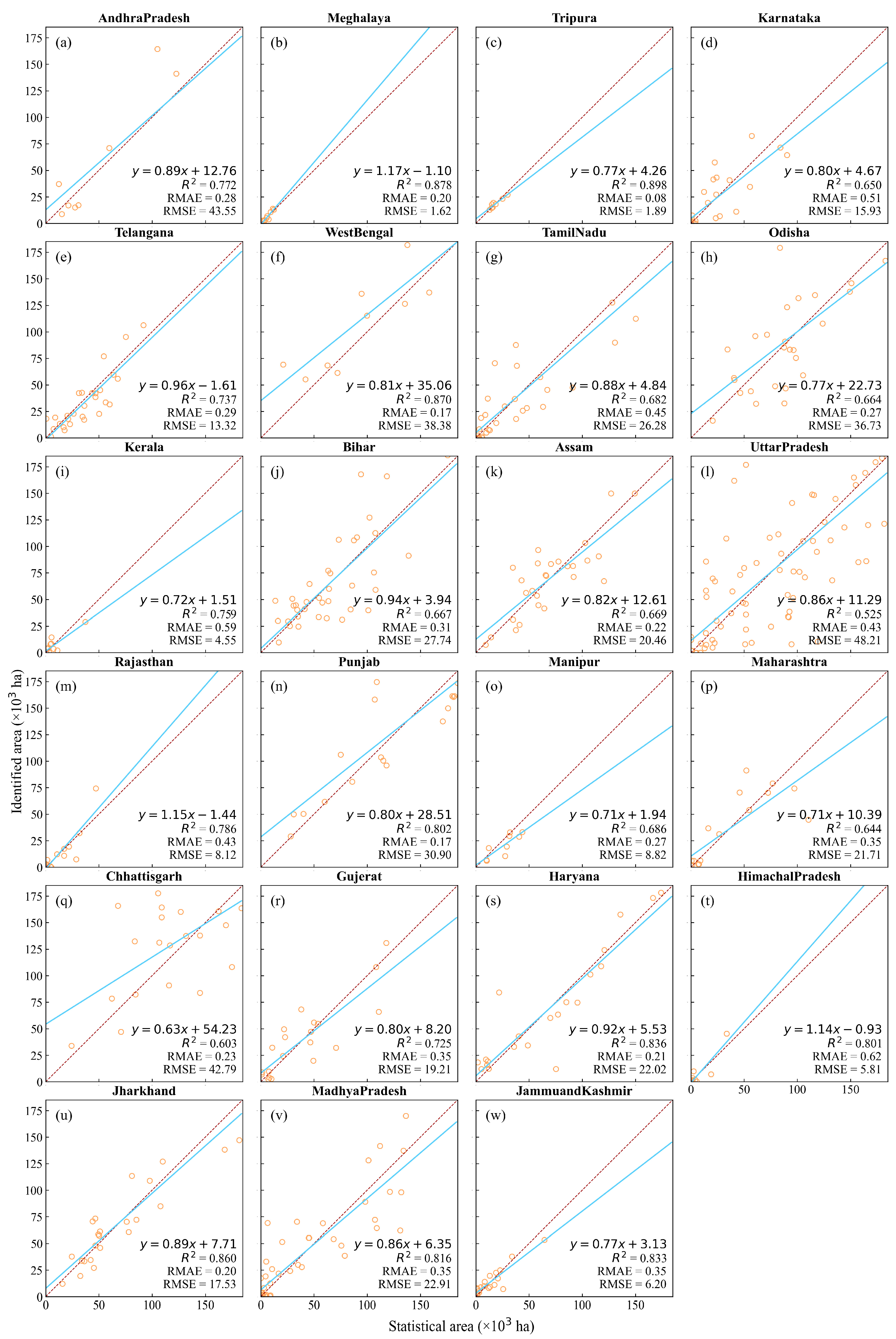
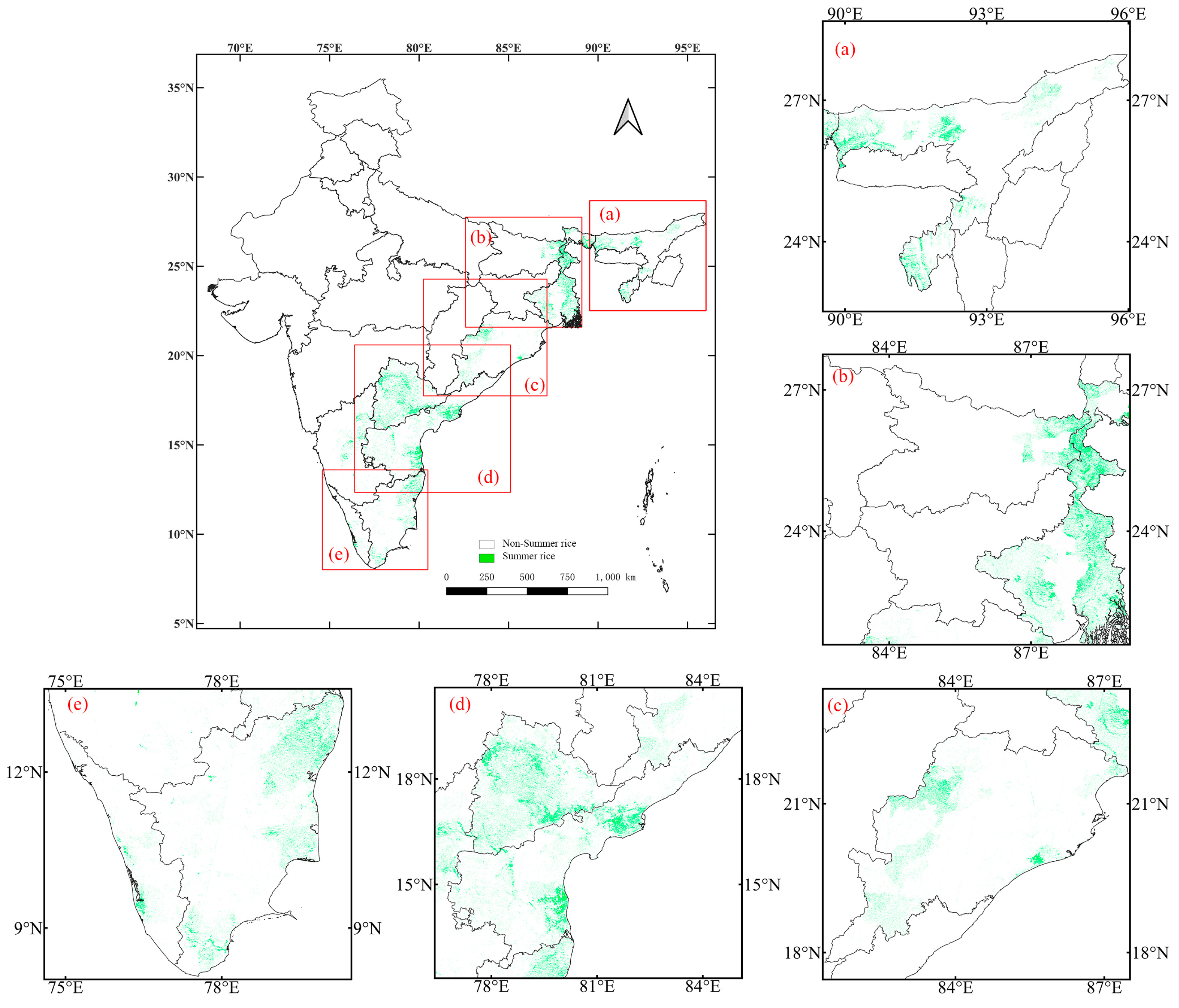
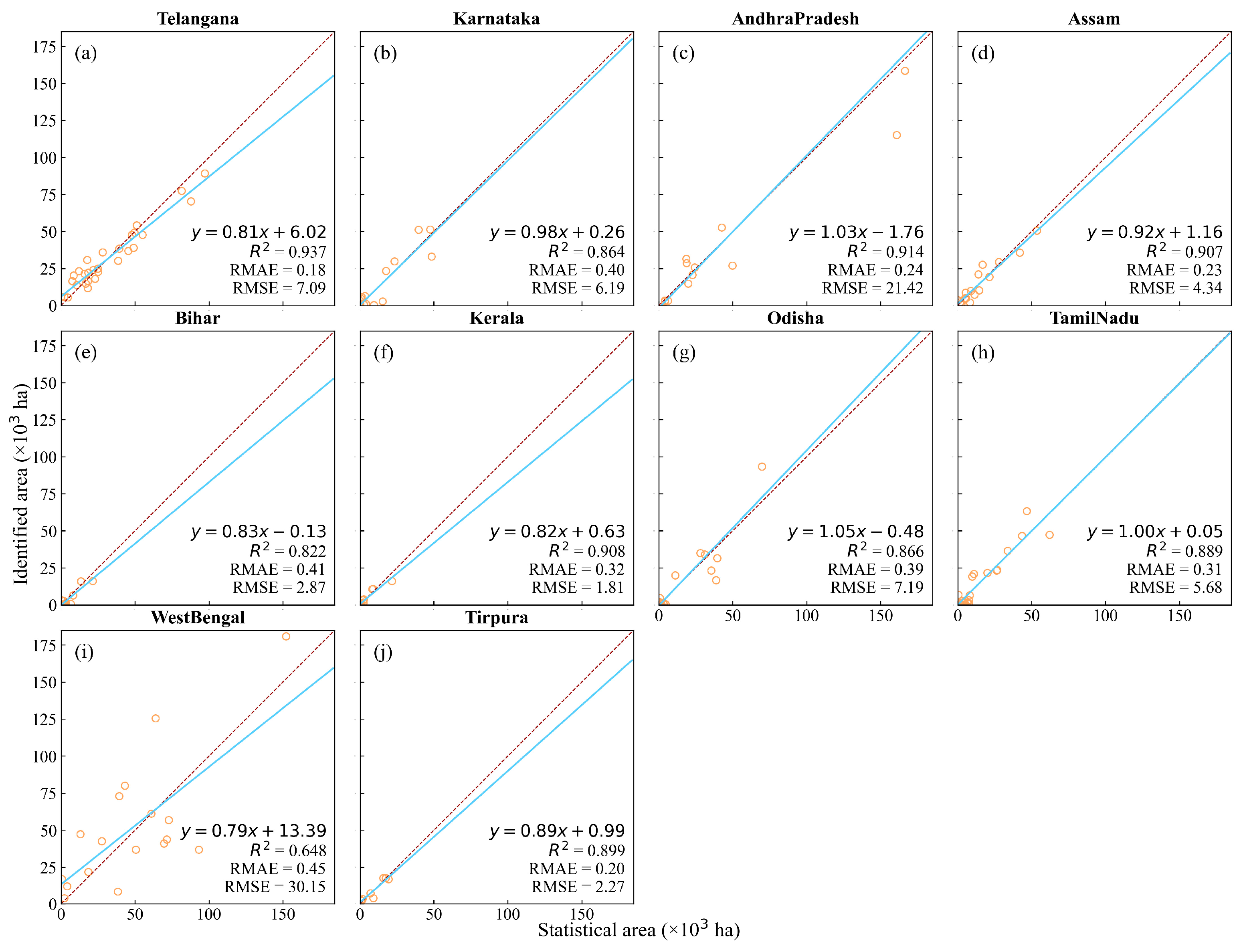
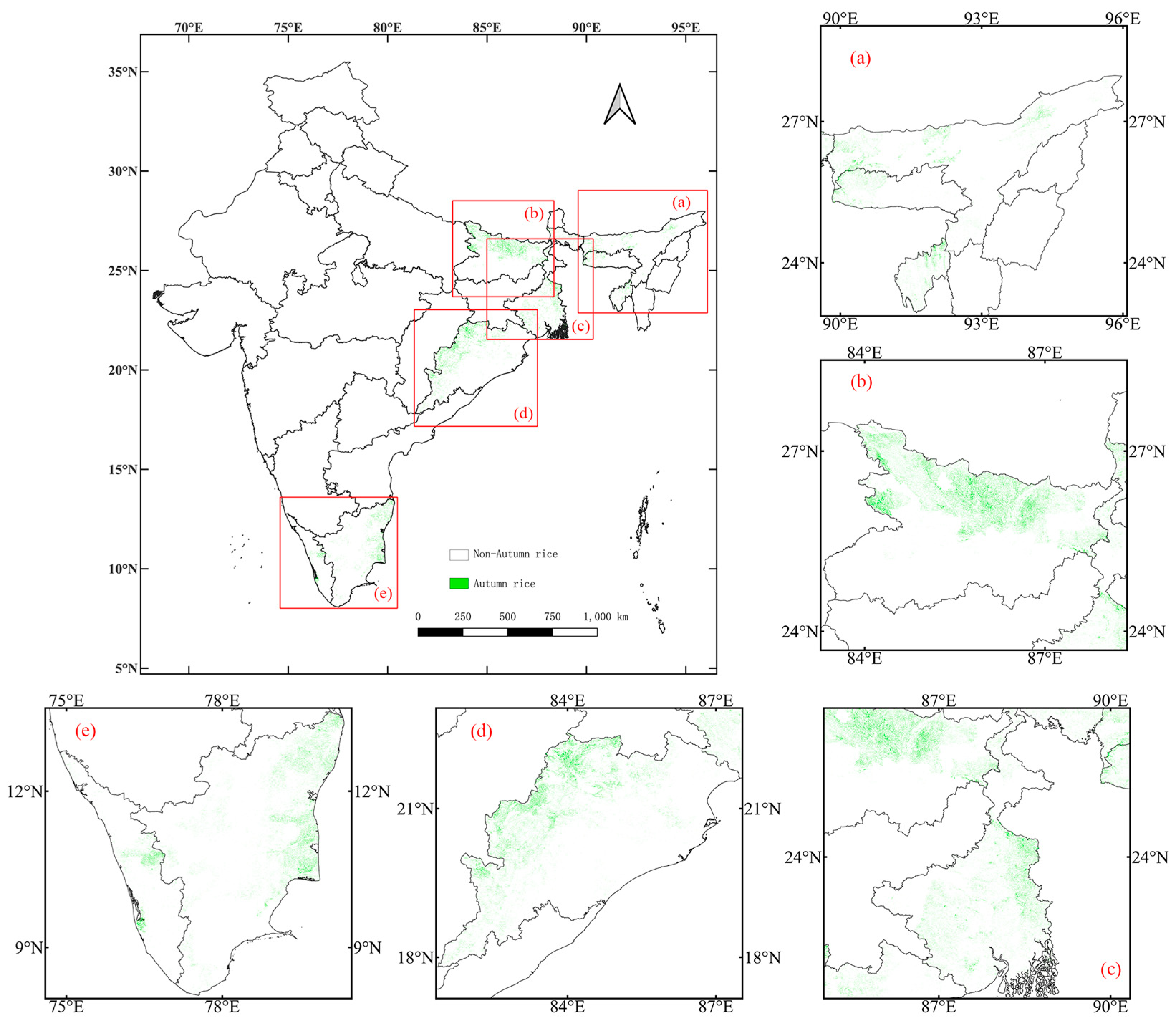
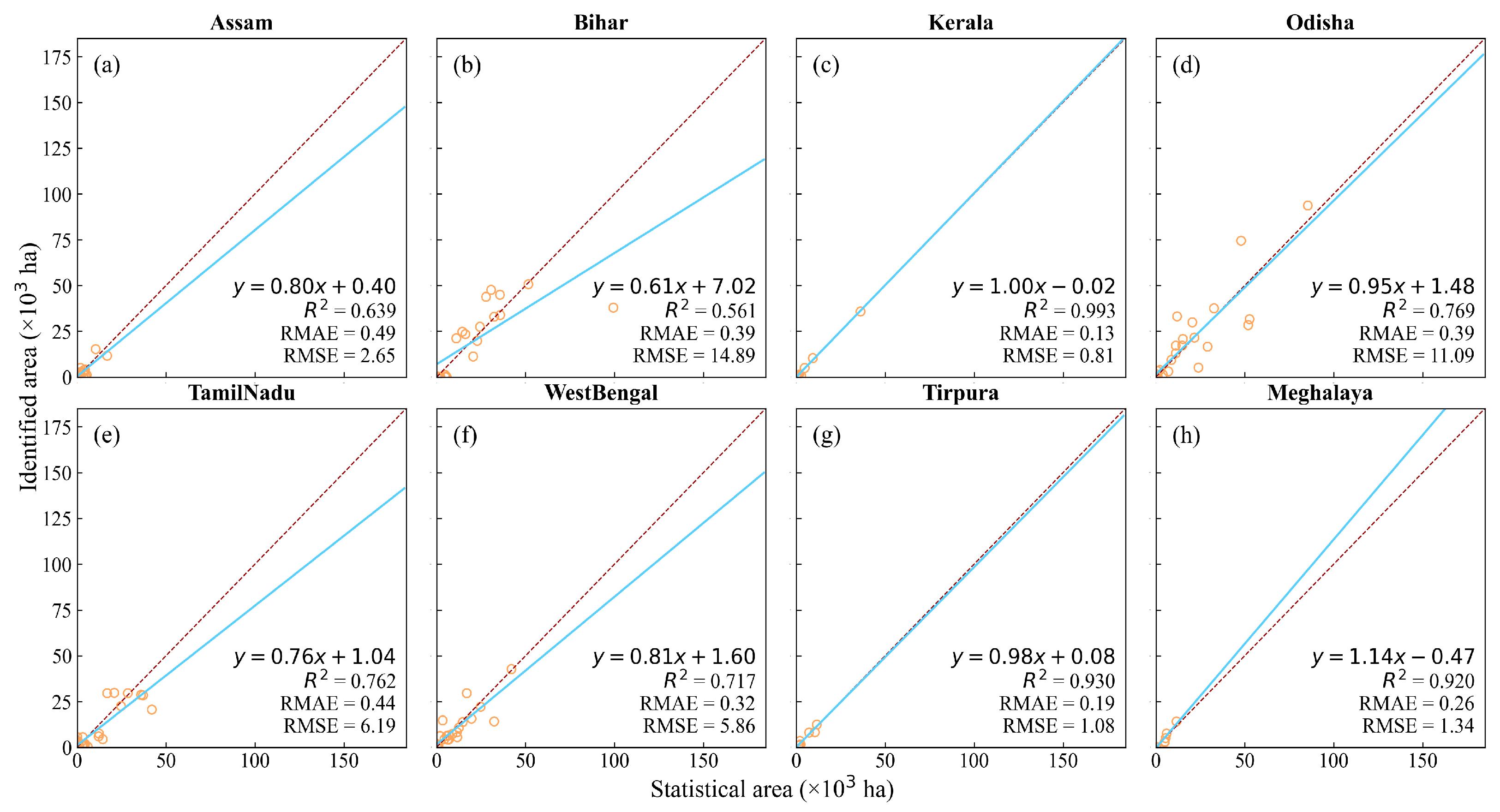


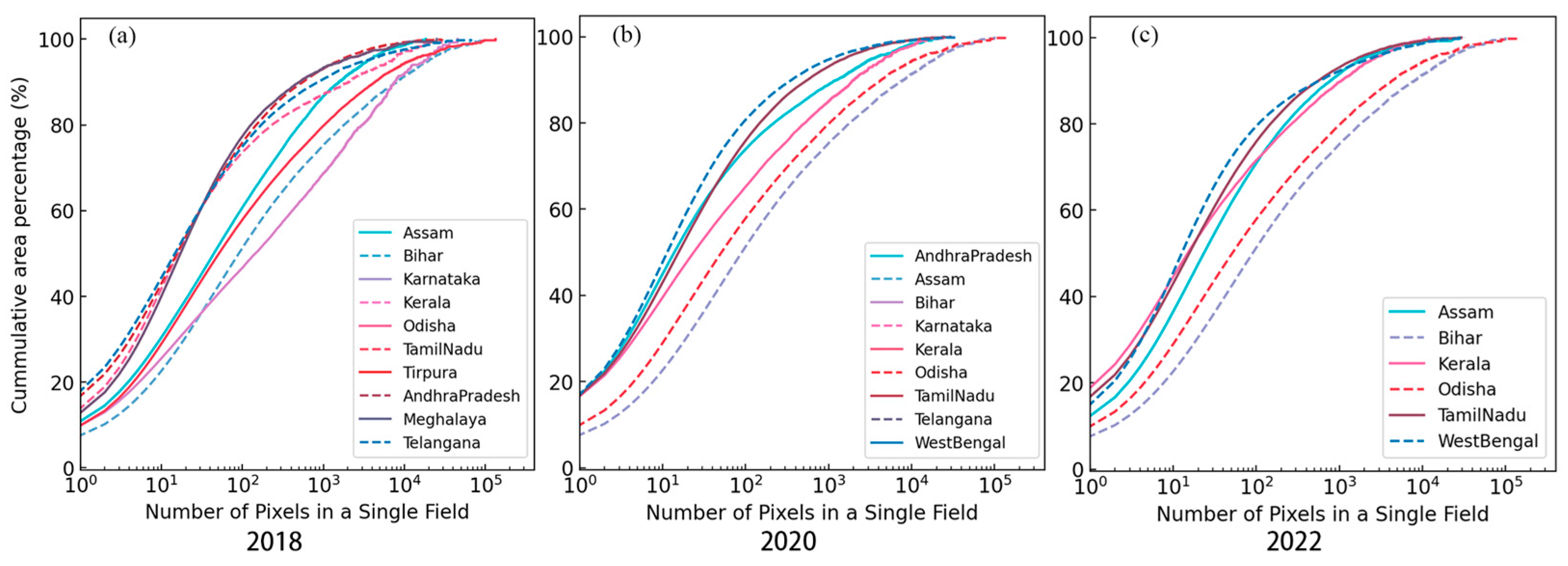
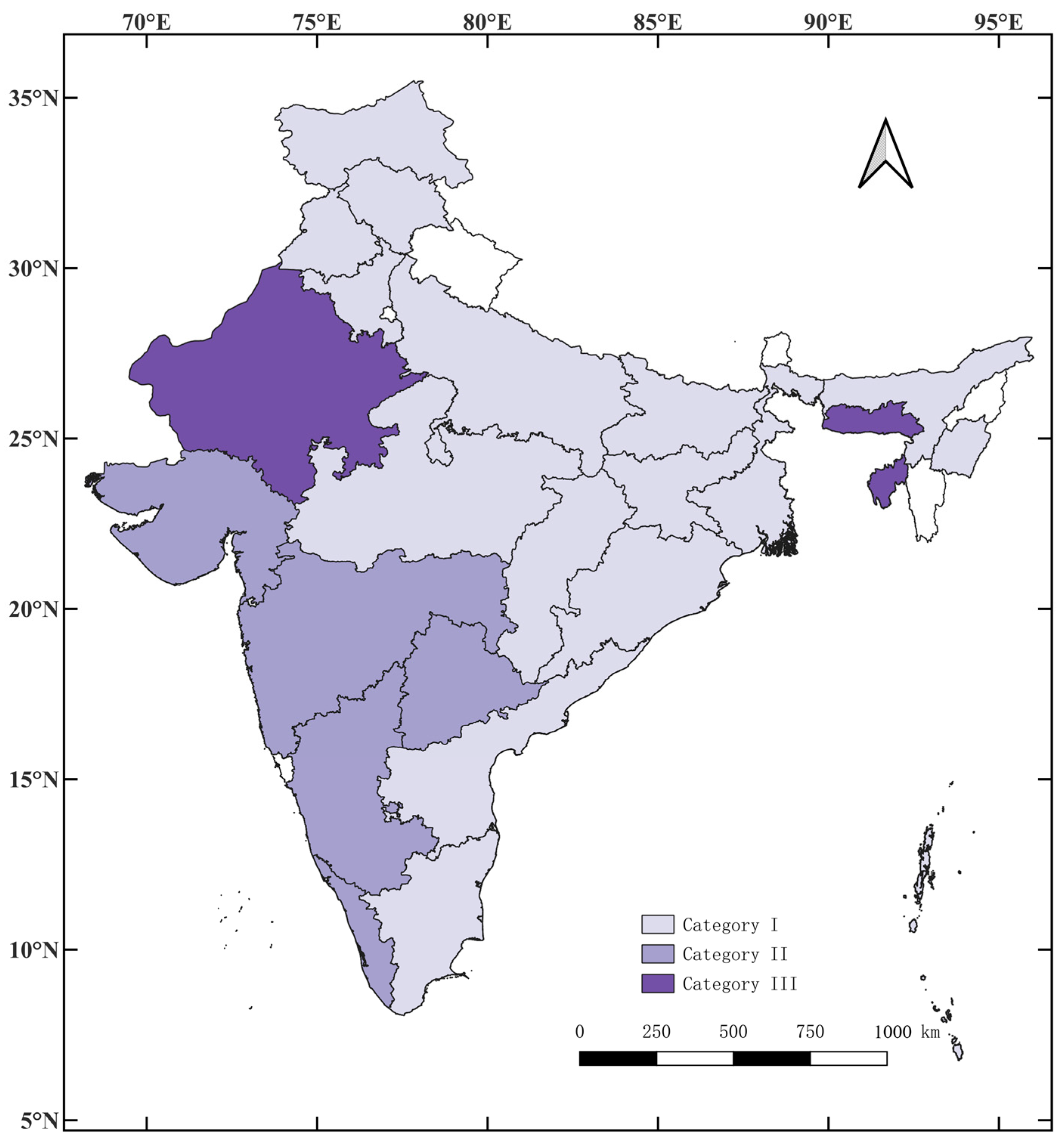
| State | Autumn | Winter | Summer | |||
|---|---|---|---|---|---|---|
| Sowing | Harvesting | Sowing | Harvesting | Sowing | Harvesting | |
| Andhra Pradesh | - | - | May–June | November–December | December–January | April–May |
| Assam | February–April | June–July | June–August | November–December | December–February | May–June |
| Bihar | May–July | September–October | July–September | November–December | January–February | May–June |
| Chhattisgarh | - | - | June–August | October–December | - | - |
| Gujrat | - | - | June–August | October–December | - | - |
| Haryana | - | - | May–July | September–November | ||
| Himachal Pradesh | - | - | June–July | September–November | - | - |
| Jammu Kashmir | - | - | April–July | September–December | - | - |
| Jharkhand | - | - | June–August | October–December | - | - |
| Karnataka | - | - | May–August | September–December | December–February | April–July |
| Kerala | April–June | August–October | September–October | January–February | December–January | March–April |
| Madhya Pradesh | - | - | June–August | Mid-September–MidDecember | - | - |
| Maharashtra | - | - | June–July | October–December | - | - |
| Manipur | - | - | June–August | October–December | - | - |
| Meghalaya | February–April | June–July | June–August | November–December | December–February | May–June |
| Odisha | May–June | September–October | Junee–August | December–January | December–January | May–June |
| Punjab | - | - | May–August | September–November | - | - |
| Rajasthan | - | - | July–August | October–December | - | - |
| Tamil Nadu | April–June | August–October | September–October | January–February | December–January | March–April |
| Tripura | February–April | June–July | July–August | November–December | December–February | May–June |
| Uttar Pradesh | May–July | September–November | ||||
| West Bengal | May–June | July–November | July–August | November–December | October–February | April–May |
| States | Rice/Other | Rice 1 | Other | UA (%) | PA (%) | OA (%) |
|---|---|---|---|---|---|---|
| West Bengal (Winter) | Rice 2 | 678 | 39 | 91.99 | 94.56 | 91.40 |
| Other | 59 | 364 | 90.32 | 86.05 | ||
| Odisha (Winter) | Rice | 296 | 18 | 81.99 | 94.27 | 82.71 |
| Other | 65 | 101 | 84.87 | 60.84 | ||
| Bihar (Winter) | Rice | 483 | 6 | 87.82 | 98.77 | 88.94 |
| Other | 67 | 104 | 94.55 | 60.82 | ||
| Assam (Winter) | Rice | 246 | 8 | 84.25 | 96.85 | 86.50 |
| Other | 46 | 100 | 92.59 | 68.49 | ||
| West Bengal (Summer) | Rice | 294 | 12 | 84.00 | 96.08 | 84.30 |
| Other | 56 | 71 | 85.54 | 55.91 | ||
| Odisha (Summer) | Rice | 177 | 26 | 87.19 | 87.19 | 83.85 |
| Other | 26 | 93 | 78.15 | 78.15 | ||
| Bihar (Summer) | Rice | 302 | 17 | 86.78 | 94.67 | 86.36 |
| Other | 46 | 97 | 85.09 | 67.83 | ||
| Assam (Summer) | Rice | 129 | 16 | 89.58 | 88.97 | 83.85 |
| Other | 15 | 32 | 66.67 | 68.09 | ||
| West Bengal (Autumn) | Rice | 154 | 31 | 81.91 | 83.24 | 82.48 |
| Other | 34 | 152 | 83.06 | 81.72 | ||
| Odisha (Autumn) | Rice | 251 | 77 | 79.43 | 76.52 | 72.95 |
| Other | 65 | 132 | 63.16 | 67.01 | ||
| Bihar (Autumn) | Rice | 122 | 13 | 84.72 | 90.37 | 85.66 |
| Other | 22 | 87 | 87.00 | 79.82 | ||
| Assam (Autumn) | Rice | 269 | 57 | 96.07 | 82.52 | 86.67 |
| Other | 11 | 173 | 75.22 | 94.02 | ||
| Telangana (Winter) | Rice | 203 | 35 | 69.05 | 85.29 | 77.34 |
| Other | 91 | 227 | 86.64 | 71.38 | ||
| Telangana (Summer) | Rice | 147 | 8 | 87.50 | 94.84 | 90.10 |
| Other | 21 | 117 | 93.60 | 84.78 | ||
| Andhra Pradesh (Winter) | Rice | 128 | 7 | 83.12 | 94.81 | 81.13 |
| Other | 26 | 117 | 94.35 | 81.82 | ||
| Andhra Pradesh (Summer) | Rice | 197 | 24 | 84.91 | 89.14 | 88.48 |
| Other | 35 | 256 | 91.43 | 87.97 | ||
| Chhattisgarh (Winter) | Rice | 358 | 15 | 86.06 | 95.98 | 87.83 |
| Other | 58 | 169 | 91.85 | 74.45 | ||
| Uttar Pradesh (Winter) | Rice | 359 | 60 | 70.81 | 85.68 | 71.82 |
| Other | 148 | 171 | 74.03 | 53.61 | ||
| Punjab (Winter) | Rice | 274 | 7 | 90.43 | 97.51 | 91.26 |
| Other | 29 | 102 | 93.58 | 77.86 |
Disclaimer/Publisher’s Note: The statements, opinions and data contained in all publications are solely those of the individual author(s) and contributor(s) and not of MDPI and/or the editor(s). MDPI and/or the editor(s) disclaim responsibility for any injury to people or property resulting from any ideas, methods, instructions or products referred to in the content. |
© 2024 by the authors. Licensee MDPI, Basel, Switzerland. This article is an open access article distributed under the terms and conditions of the Creative Commons Attribution (CC BY) license (https://creativecommons.org/licenses/by/4.0/).
Share and Cite
Chen, X.; Shen, R.; Pan, B.; Peng, Q.; Zhang, X.; Fu, Y.; Yuan, W. A High-Resolution Distribution Dataset of Paddy Rice in India Based on Satellite Data. Remote Sens. 2024, 16, 3180. https://doi.org/10.3390/rs16173180
Chen X, Shen R, Pan B, Peng Q, Zhang X, Fu Y, Yuan W. A High-Resolution Distribution Dataset of Paddy Rice in India Based on Satellite Data. Remote Sensing. 2024; 16(17):3180. https://doi.org/10.3390/rs16173180
Chicago/Turabian StyleChen, Xuebing, Ruoque Shen, Baihong Pan, Qiongyan Peng, Xi Zhang, Yangyang Fu, and Wenping Yuan. 2024. "A High-Resolution Distribution Dataset of Paddy Rice in India Based on Satellite Data" Remote Sensing 16, no. 17: 3180. https://doi.org/10.3390/rs16173180
APA StyleChen, X., Shen, R., Pan, B., Peng, Q., Zhang, X., Fu, Y., & Yuan, W. (2024). A High-Resolution Distribution Dataset of Paddy Rice in India Based on Satellite Data. Remote Sensing, 16(17), 3180. https://doi.org/10.3390/rs16173180






